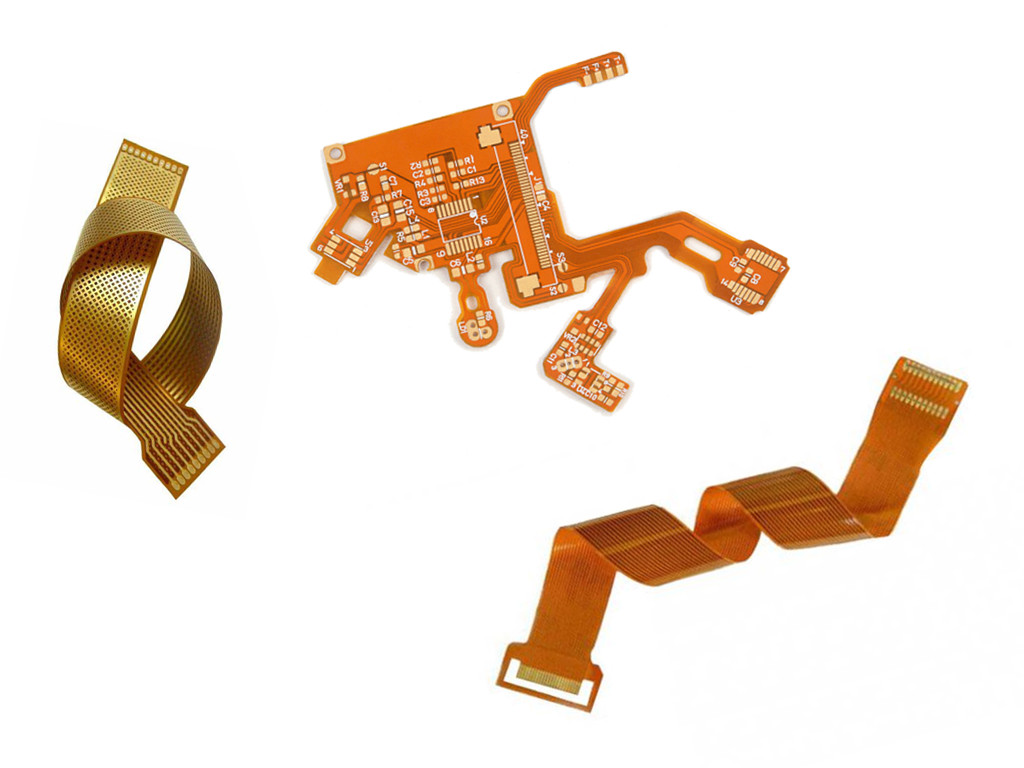Flexible PCB Manufacturer & Assembly Service
 Add To Cart
Contact Us
Add To Cart
Contact Us
Description
Flexible PCB Manufacturer & Assembly – One-stop services
Hitech Circuits Co.,Ltd is a professional flexible pcb, FPC printed circuit board manufacturer, supplier from China, due to its features of bendable, reducing product size, good heat dissipation and solderability, easy assembly and low overall cost etc, it is widely used in mobile phones, wearable smart devices, automobiles, medical treatment, and industrial control etc. If you are looking for a reliable flexible PCB board partner in China, please don’t hesitate to contact sales@hitechcircuits.com

SMT: Technical Points for Mounting Flexible PCB
There are many differences between the flexible PCB SMT process and the SMT solution of the traditional rigid PCB. If you want to do the SMT process of the flexible PCB, the most important thing is positioning, because the hardness of the flexible PCB is not enough, it is softer, and if the special carrier is not used, it cannot be fixed and transmitted, and the basic SMT processes such as printing, patch, and furnaces cannot be completed. The key points of pre-processing, fixing, printing, patch, reflux welding, testing, and division plates of flexible PCB in the production of SMT production are specified as below.
1. Flexible PCB pretreatment
The flexible PCB is softer, and it is generally not a vacuum packaging when it leaves the factory. It is easy to absorb the water in the atmosphere during the transportation and storage procedures. You need to prepare pre-baking treatment before the SMT patch process and slowly discharge the water, otherwise, under the impact of reflux welding at high temperatures, the water absorbed by the FPC quickly vaporizes into steam, which can easily lead to poor flexible PCB layer departure and foaming.
Generally, pre-baking temperatures are 80-100℃ for 4-8 hours, however, under the special condition, the temperature can be raised to more than 125℃, but need to shorten the baking time accordingly. Before baking, be sure to take a small sample test to determine whether the flexible PCB can withstand set baking temperatures, you can also consult flexible PCB manufacturers with appropriate baking process. When baking, don’t put too much flexible PCB for one time, 10-20 panels are more suitable. Some flexible PCB manufacturers may put a piece of paper among each flexible PCB to isolate them and at the same time need to check if the paper can bear the baking temperature, if it cannot be, then pull off the paper before baking. After baking, if the flexible PCB does not have the issues like visible change in color, out of shape, and up warp, etc and then need the IPQC to do sampling inspection.
2. Flexible PCB paste printing
The flexible PCB does not have a very special requirement for the ingredients of the weld paste. The size and metal content of the tin ball particles depends on whether there is a fine pitch IC on the flexible PCB, but the printing performance of the solder paste is higher in FPC, welded paste should be easy to print and eliminate modeling and can be firmly stacked to the flexible PCB surface, there will not be adversely obstructing the steel mesh leakage or collapse after printing.
Because the flexible PCB is loaded on the carrier plate, the flexible PCB has a high-temperature resistant tape for positioning to make its plane inconsistent, so the printing surface of flexible PCB cannot be as smooth as rigid PCB, and has same thickness and hardness, therefore, it is not suitable to use metal scraper, but should use the hardness of 80-90 degrees of polyurethane scraper. It is best to have an optical positioning system for tin paste printing machine, otherwise it will have a great impact on the quality of printing. Although the flexible PCB is fixed on the carrier, there will always be some small gaps between flexible PCB and the carrier, this is the biggest difference from the rigid board, so the setting of the machine parameters also has a greater impact on printing effects.
Printing station is also the key station to prevent flexible PCB dirt, workers need to wear finger stall during operation, at the same time to keep the station clean, and often wipe the steel mesh, to prevent solder paste pollution of the gold finger and gold buttons of flexible PCB.
3. Flexible PCB mounting
According to the characteristics of the product, the number of components, and the efficiency of the patch, needs to use the middle and high-speed patch machines to install. Since the optical mark label for positioning is available on each flexible PCB, SMD paste on the flexible PCB is not very different from the installation on the rigid PCB. It should be noted that although the flexible PCB is fixed on the carrier board, its surface cannot be as flat as rigid board, there will definitely be little gap between flexible PCB and the carrier, therefore, the descending height and blowing pressure of the suction nozzle should be set accurately, and the moving speed of the suction nozzle should be reduced. At the same time, the majority of flexible PCB are connected plates, and the finished product rate of flexible is relatively low, so it is normal for the whole panel to contain some defective board, which requires the bad marks recognition function of the SMT machine, otherwise, the production efficiency will be greatly reduced when the production of this kind of non-integrated panel is good.
4. Flexible PCB Reflow soldering
Mandatory hot air convection infrared reflow furnace should be used, so that the temperature on the flexible PCB can be more uniform change, reduce the occurrence of poor welding. If single-sided tape is used, it can only fix the four sides of the flexible PCB, and the middle part is deformed in the hot air condition, so that the welding plate is prone to tilt, and the molten tin (liquid tin at high temperature) will flow and produce air welding, continuous welding and tin beads, so that the process defect rate is high.
(1).Temperature curve test method:
Due to the different heat absorption properties of the carrier plate and the different types of components on the flexible PCB, their temperature rises at different rates after being heated in the reflow welding process, and the heat absorbed is also different, therefore, carefully setting the temperature curve of reflow furnace has a great influence on the welding quality. The relatively safe method is that according to the load interval during actual production, put two pieces carrier plates with flexible PCB on the front and back of the test board, at the same time, a component is installed on the flexible PCB of the test carrier plate, and the test temperature probe is welded to the test point with high temperature solder wire, meanwhile fix the probe wire on the carrier plate with high temperature resistant tape. Note that high-temperature tapes cannot cover the test point, the testing point should be selected at the welded joints and QFP pins near the side of the carrier plate, such test results can better reflect the real situation.
(2).Settings of temperature curve:
In the furnace temperature debugging, because the flexible PCB temperature uniformity is not good, so it is best to use the temperature curve of temperature rise/heat preservation/reflux, so that the parameters of each temperature area is easy to control, in addition, flexible PCB and components are less affected by heat shock, in this way, the parameters of each temperature area are easy to control. In addition, according to the experience, it is best to adjust the temperature of the furnace to the lower limit of the technical requirements of the welding paste, the wind speed of the welding furnace generally uses the minimum wind speed that the stove can be used, the back welding furnace chain should have good stability and cannot be shake.
5. The Test Division of Flexible PCB
Because the carrier plate absorbs heat in the furnace, especially the aluminum carrier plate, the temperature is higher when it comes out of the oven, so it is best to add a forced cooling fan at the furnace to help rapid cooling, at the same time, operators need to wear heat insulating gloves to avoid being burned by the high temperature carrier plate, when taking the finished flexible PCB from the carrier plate, the force should be uniform and cannot use much force to avoid the flexible PCB being torn or generate crease.
Doing visual inspection for the flexible PCB under the 5x magnifying glass, focusing on checking the surface residual gum, color change, golden finger dipping tin, tin bead, IC pin empty welding, and connected welding, because the flexible PCB surface cannot be flat, the misjudgment rate of AOI is high, so flexible PCB is generally not suitable for AOI checks, but through the use of special testing fixtures, flexible PCB can complete ICT and FCT testing.
Because flexible PCBs are mostly connected together, workers may need to do board split before the ICT and FCT testing, although tools such as blades and scissors can also be used to complete the division operations, the work efficiency and the quality of the operation are low and the scrap rate is high. If it is a large quantity of special-shaped flexible PCB, it is recommended to make a special stamping section mold and perform stamping segmentation, which can greatly improve the operating efficiency, meanwhile, the edge of the flexible PCB is neat and beautiful, it can effectively avoid welded tin cracks.
Conclusion
For SMD mounting on the flexible PCB, accurate positioning and fixing of the flexible PCB are the key points, and the key of fixing is to make the appropriate carrier plate; Secondly is the pr -baking, printing, patch and reflux welding of flexible PCB, obviously, the FPC's SMT process is more difficult than the rigid PCB, so it is necessary to accurately set the process parameters and strict production process management is also important. It is necessary to ensure that operators strictly implement every rule of SOP, engineers and IPQC should strengthen inspection, and discover abnormal conditions of production line in time, analyze the causes and take necessary measures, so as to control the defect rate of production line.

0086-755-29970700
sales@hitechpcb.com; sales@hitechcircuits.com
2F, Building C, Suojia Technology Park, Hangcheng, Bao’an, Shenzhen, Guangdong, China 518126
 Chinese
Chinese English
English Russian
Russian Spanish
Spanish Portuguese
Portuguese




